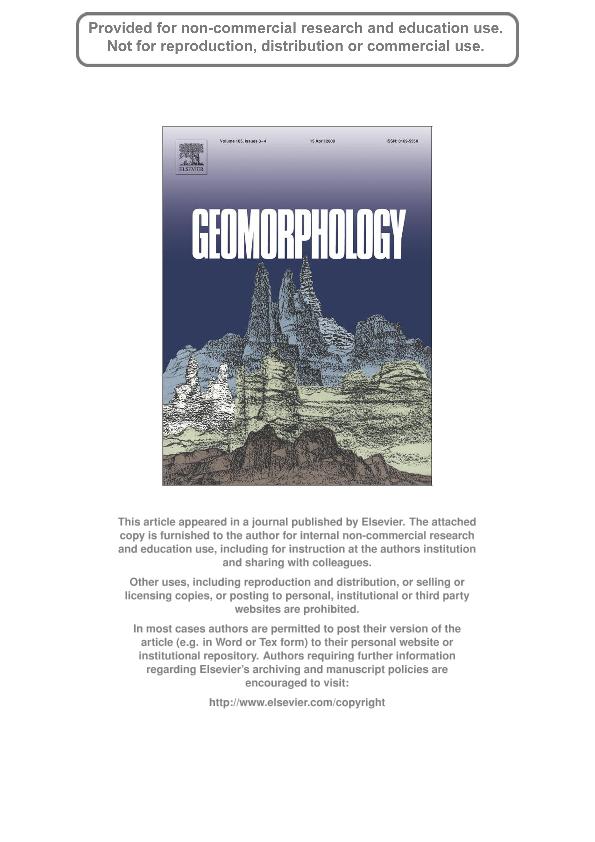Mostrar el registro sencillo del ítem
dc.contributor.author
Glasser, Neil F.
dc.contributor.author
Ghiglione, Matias

dc.date.available
2019-10-04T17:58:02Z
dc.date.issued
2009-04
dc.identifier.citation
Glasser, Neil F.; Ghiglione, Matias; Structural, tectonic and glaciological controls on the evolution of fjord landscapes; Elsevier Science; Geomorphology; 105; 3-4; 4-2009; 291-302
dc.identifier.issn
0169-555X
dc.identifier.uri
http://hdl.handle.net/11336/85239
dc.description.abstract
The fjord landscape of South America, stretching ~ 1500 km between Golfo Corcovado (~ 43°S) and Tierra del Fuego (~ 56°S), is the largest continuous fjord landscape on Earth. This paper presents the results of new structural geological and geomorphological mapping of this landscape using optical satellite images and digital elevation models. First-order geological structures are represented by strike-slip faults forming lineaments up to hundreds of kilometres long. The strike-slip faulting has been active since Late Cretaceous times and is responsible for the presence of a conspicuous structural cleavage visible as lineaments up to ~ 10 km long. A detailed analysis of these second-order lineaments from digital image data was carried out in three sectors. In Sector 1, located northwest of the North Patagonian Icefield, there are three distinct mean orientations, characterized by a main nearly orogen-parallel orientation (az. ~ 145°) and two orogen-oblique secondary orientations (az. ~ 20° and az. ~ 65°). In Sector 2, located west of the South Patagonian Icefield, there are also three separate mean orientations, with most of the lineaments concentrated between azimuths 0° and 80° (mean at ~ 36°); and two other orogen-oblique means at azimuth ~ 122° and ~ 163°. In Sector 3, around the Cordillera Darwin, there is a single main orogen-parallel mean at ~ 100-115°. In all three sectors, mapped fjord orientations bear a striking similarity to the structural data, with fjords orientated preferentially in the same direction as structural lineaments. We infer that successive glaciations followed the same ice-discharge routes, widening and deepening pre-existing geological structures at the expense of the surrounding terrain to create the fjord landscape. This study has broader implications for ice sheet reconstructions and landscape evolution beneath ice sheets because we demonstrate that the primary control on fjord development in glaciated areas is geological and not glaciological.
dc.format
application/pdf
dc.language.iso
eng
dc.publisher
Elsevier Science

dc.rights
info:eu-repo/semantics/openAccess
dc.rights.uri
https://creativecommons.org/licenses/by-nc-sa/2.5/ar/
dc.subject
FJORDS
dc.subject
GLACIAL GEOMORPHOLOGY
dc.subject
PATAGONIA
dc.subject
SOUTH AMERICA
dc.subject
STRUCTURAL GEOLOGY
dc.subject
TECTONICS
dc.subject.classification
Geología

dc.subject.classification
Ciencias de la Tierra y relacionadas con el Medio Ambiente

dc.subject.classification
CIENCIAS NATURALES Y EXACTAS

dc.title
Structural, tectonic and glaciological controls on the evolution of fjord landscapes
dc.type
info:eu-repo/semantics/article
dc.type
info:ar-repo/semantics/artículo
dc.type
info:eu-repo/semantics/publishedVersion
dc.date.updated
2019-10-01T14:52:07Z
dc.journal.volume
105
dc.journal.number
3-4
dc.journal.pagination
291-302
dc.journal.pais
Países Bajos

dc.journal.ciudad
Amsterdam
dc.description.fil
Fil: Glasser, Neil F.. Aberystwyth University; Reino Unido
dc.description.fil
Fil: Ghiglione, Matias. Consejo Nacional de Investigaciones Científicas y Técnicas. Oficina de Coordinación Administrativa Ciudad Universitaria. Instituto de Estudios Andinos "Don Pablo Groeber". Universidad de Buenos Aires. Facultad de Ciencias Exactas y Naturales. Instituto de Estudios Andinos "Don Pablo Groeber"; Argentina
dc.journal.title
Geomorphology

dc.relation.alternativeid
info:eu-repo/semantics/altIdentifier/doi/http://dx.doi.org/10.1016/j.geomorph.2008.10.007
dc.relation.alternativeid
info:eu-repo/semantics/altIdentifier/url/https://www.sciencedirect.com/science/article/pii/S0169555X08004583
Archivos asociados
